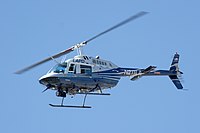
Photo from wikipedia
Abstract Auxiliary lift and/or thrust on a compound helicopter can introduce complex aerodynamic interactions between the auxiliary lift and thrust components and the main rotor. In this study high-fidelity computational… Click to show full abstract
Abstract Auxiliary lift and/or thrust on a compound helicopter can introduce complex aerodynamic interactions between the auxiliary lift and thrust components and the main rotor. In this study high-fidelity computational fluid dynamics analyses were performed to capture the various aerodynamic interactions which are occurring for the Airbus RACER compound helicopter, featuring a box-wing design for auxiliary lift in cruise and wingtip-mounted lateral rotors in pusher configuration for auxiliary thrust in cruise and counter-torque in hover. Although the study was limited to a specific geometry, the effects and phenomena are expected to be to some extent applicable in general for compound helicopters and wingtip-mounted rotors in pusher configuration. A quantitative indication of the aerodynamic interaction effects could be established by leaving away different airframe components in the simulations. The downwash of the main rotor was found to cause a small negative angle of attack in cruise for the wings and lateral rotors and impinged directly on the lateral rotors in hover, resulting in moderate to very significant sinusoidally varying blade loading. The wing increased lateral rotor propulsive efficiency in cruise through its wingtip rotational flowfield and to a lesser extent through its wake. An upstream effect of the lateral rotors on the wing loading was also found. In hover the wing caused a net increase in left lateral rotor thrust as the deflection of the main rotor flow towards the rotor resulted in a local thrust decrease and the low momentum inflow to the rotor from the wake of the wing resulted in a local thrust increase. A small thrust decrease for the right lateral rotor was found due to the wing disturbing its slipstream as this rotor produced reversed thrust. In general, very significant aerodynamic interaction effects can be expected when a main rotor, lateral rotors and wing are in proximity to each other.
Journal Title: Aerospace Science and Technology
Year Published: 2020
Link to full text (if available)
Share on Social Media: Sign Up to like & get
recommendations!